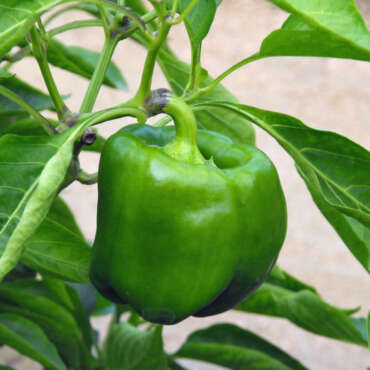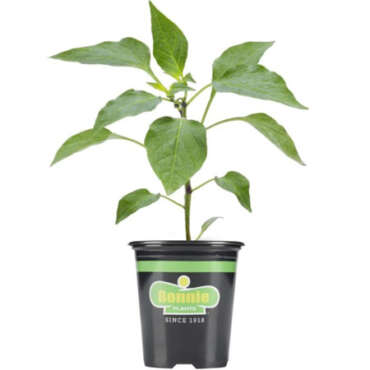Product Description
Bell Peppers
In most American vegetable gardens, peppers are second only to tomatoes in popularity, and it’s easy to see why. Few vegetables offer as much versatility in size, shape, color, and flavor. Beyond the familiar bell pepper, you’ll find a vast selection of cultivars—some sweet, some hot, and a few that are a bit of both.
If you don’t care for the taste of peppers, you can still grow them for their ornamental attributes. With their white flowers, colorful fruit, and upright growth habit, pepper plants are just as welcome in flower beds and borders as they are in the vegetable garden. In fact, many newer cultivars have been bred just for the purpose of showing them off.
BASICS
Botanical names:
- Capsicum annuum (the largest variety of plants)
- Capsicum chinense (the hottest peppers, including habañeros and ghost chiles)
- Capsicum frutescens (best known for the Tabasco pepper)
Zones:
Perennial in Zones 9-11, grown as an annual elsewhere.
Height:
Typically 18 to 36 inches, with the exception of dwarf varieties, which range in height from 6 to 12 inches.
Exposure:
Full sun (6-8 hours per day)
Days to maturity:
Most sweet peppers mature 60 to 90 days after transplanting in the garden. Hot peppers can take up to 150 days to mature.
How hot is it?
Heat value is often expressed in Scoville heat units (SHU), ranging from mild (0 to 700) to volcanic (above 800,000!). Most peppers fall in the moderate to hot range. Ratings can fluctuate depending on the climate and growing conditions. They can even vary on the same plant, with one pepper tasting fiery hot and another mild.
PLANTING PEPPER PLANTS
When to plant:
Transplant peppers after all danger of frost has passed, the weather is consistently warm, and the soil has reached a temperature of at least 65° F. Before transplanting, harden off your pepper plants outdoors at increasing time intervals.
Cold climate planting tip: Jumpstart soil warming by covering it with black plastic for at least a week before planting time.
Where to plant:
In full sun (at least 8 hours per day), in nutrient-rich, well-draining soil that contains plenty of organic matter.
How to plant:
Before planting, work some organic matter into the soil. Dig holes deep enough to set your plants in the ground at the same level they were in their pots. Immediately after transplanting, water thoroughly. To help retain moisture and control weeds, cover the soil around your plants with a layer of finely shredded, organic mulch.
Pepper plant spacing:
Space plants about 18 to 24 inches apart, depending on their size at maturity.
Planting pepper seeds:
Start pepper seeds indoors 8 to 12 weeks before transplanting. Pepper seedlings need warm soil temperature (about 80° F) for germination, daytime temperatures averaging 70° to 80° F, and nighttime temperatures no lower than 60° F. Keeping the soil evenly moist and providing adequate light exposure (see: Starting Seeds Under Fluorescent Lights) are also essential to getting your seedlings off to a strong start.
Growing peppers in pots:
Because of their upright, bushy growth habit, pepper plants are well suited for growing in containers—a great option if you have limited garden space. Choose a container that allows ample space for root development and has holes for good drainage. Most plants, with the exception of dwarf varieties, will need a minimum pot size of 5 gallons. Typically, the larger the fruit, the larger the pot required.
PEPPER PLANT CARE & HARVESTING
Pruning pepper plants:
As a general rule, pruning pepper plants isn’t necessary. Peppers can be sensitive to sun scald, so removing foliage can expose them to the sun too much.
Water:
The key to watering peppers is moderation. Too little will cause the leaves to wilt and the flowers to drop; too much will result in waterlogged roots. Keep your plants evenly moist by giving them the equivalent of an inch of water per week. They may need more water when the weather is hot and sunny.
Fertilizer for pepper plants:
Fertilize your peppers with a well-balanced vegetable fertilizer when you plant them and again later in the summer when the first blossoms appear. Avoid high-nitrogen fertilizers, which will stimulate foliage growth but result in less fruit production.
If you find that your plants are producing a lot of flowers but little fruit, this is often caused by a lack of magnesium. To give your plants a boost, spray the leaves with a solution of Epsom salts (using about 2 teaspoons per quart of warm water) or side dress your plants with 1 tablespoon of Epsom salts per foot of plant height.
Staking pepper plants:
Most pepper plants, with the exception of dwarf types, should be staked or caged for support to prevent their brittle branches from breaking and to keep the plants from toppling over under the weight of the fruit as it matures. When tying plants to stakes use a stretchy material, such as strips of nylon hose, that can expand as the stems enlarge. Don’t use wire or twine, which can choke off the plant as it grows.
Harvesting peppers:
Peppers can be harvested at any time, but they will not reach their full color or flavor until fully ripe. Picking some of your peppers early, while they are still green, will encourage the plant to develop more fruit. Seek a balance by leaving some peppers on each plant to fully ripen and harvesting others as soon as they reach the desired size. Cut your peppers off cleanly with a garden pruner, rather than pulling them off, to avoid breaking the fragile branches.
Harvesting tip: When harvesting and preparing super-hot peppers such as habañeros and ghost chiles, always protect your skin by wearing gloves.
Disesases and pests:
The same pests and diseases that afflict other members of the nightshade family will occasionally attack peppers. Common diseases include bacterial leaf spot, blossom-end rot, tobacco mosaic virus, and anthracnose. Pests to watch out for include cutworms, tomato hornworms, aphids, spider mites, and thrips. You can avoid many of these problems by planting disease-resistant pepper varieties and practicing crop rotation.
Specifications
- Weight: 15 lb
- >>: Colors are approximate


